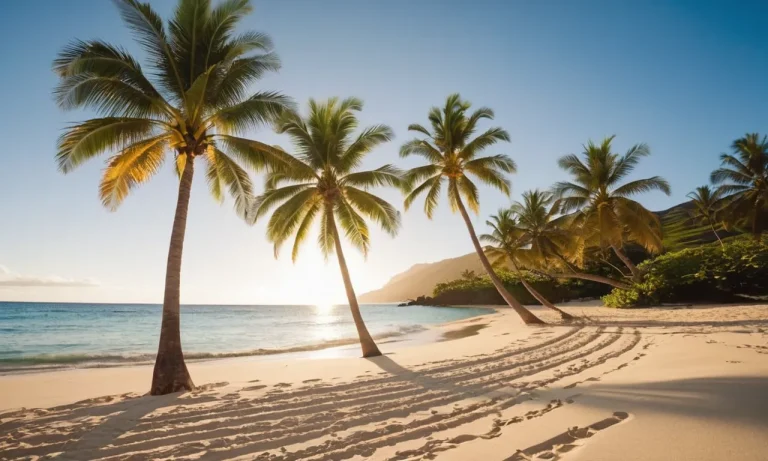Save money on your next flight
Skyscanner is the world’s leading flight search engine, helping you find the cheapest flights to destinations all over the world.
With over 6,000 miles of coastline and a vibrant fusion of cultures, the Hawaiian Islands have long captured the imagination of travelers from around the world. But just how large is the tropical paradise of Hawaii compared to the Sunshine State of Florida? In this comprehensive guide, we’ll examine the relative size and key statistics of these two iconic vacation destinations.
If you’re short on time, here’s a quick answer to your question: Hawaii is smaller than Florida in terms of total land area, but it has a longer coastline.
Total Land Area
Florida’s Land Area
Florida, known as the Sunshine State, is famous for its beautiful beaches, vibrant cities, and diverse ecosystems. In terms of land area, Florida is the 22nd largest state in the United States. The total land area of Florida is approximately 53,625 square miles (138,887 square kilometers). This includes both land and water areas. With its extensive coastline along the Atlantic Ocean and the Gulf of Mexico, Florida boasts a significant amount of coastal territories.
Hawaii’s Land Area
Hawaii, also known as the Aloha State, is a tropical paradise consisting of a group of islands located in the Pacific Ocean. While it may be a popular vacation destination, Hawaii is actually the 43rd largest state in terms of land area. The total land area of Hawaii is approximately 6,423 square miles (16,635 square kilometers). Despite its smaller size, Hawaii is home to stunning landscapes, including active volcanoes, lush rainforests, and breathtaking beaches.
Land Area Comparison
When comparing the land area of Florida and Hawaii, it is clear that Florida is significantly larger. In fact, Florida is approximately 8 times larger than Hawaii in terms of land area. To put it into perspective, you could fit about 8 Hawaiian Islands within the land area of Florida! This stark difference in size is due to the fact that Florida is a continental state, while Hawaii is an archipelago consisting of multiple islands.
It’s important to note that while Hawaii may be smaller in size, it doesn’t diminish the beauty and allure of the islands. Each island in Hawaii has its own unique charm and offers a multitude of attractions and activities for visitors to enjoy. From exploring the volcanic landscapes of the Big Island to snorkeling in the crystal-clear waters of Maui, Hawaii offers a world of adventure in a compact package.
If you’d like to learn more about the land areas of Florida and Hawaii, you can visit the official websites of the Florida State Parks and the Department of Land and Natural Resources of Hawaii.
Coastline Lengths
Florida’s Coastline
Florida, known for its beautiful beaches and vibrant coastal cities, boasts an impressive coastline that stretches approximately 1,350 miles. This extensive shoreline is the result of Florida’s unique geography, with its peninsula jutting out into the Atlantic Ocean on the east coast and the Gulf of Mexico on the west coast. The Sunshine State is home to numerous popular coastal destinations, including Miami, Fort Lauderdale, and Clearwater Beach.
Hawaii’s Coastline
While Florida’s coastline is undoubtedly impressive, it pales in comparison to the breathtaking beauty of Hawaii’s shores. Despite being a collection of islands in the middle of the Pacific Ocean, Hawaii boasts a coastline that spans approximately 750 miles. This may seem shorter than Florida’s coastline at first glance, but it is important to remember that Hawaii’s shoreline is spread across multiple islands, each with its own unique and stunning coastline.
Coastline Comparison
When we compare the coastline lengths of Hawaii and Florida, it is clear that Florida has a longer shoreline overall. However, it is important to note that Hawaii’s coastline is spread across multiple islands, which means that each island has its own distinct coastline to explore. From the black sand beaches of the Big Island to the rugged cliffs of Kauai, Hawaii offers a diverse range of coastal landscapes that are truly awe-inspiring.
Regardless of the size comparison, both Hawaii and Florida offer an abundance of coastal beauty and recreational opportunities. Whether you prefer the warm waters and tropical landscapes of Hawaii or the vibrant beach culture of Florida, each state has its own unique charm that will leave you in awe of its natural wonders.
For more information on Florida’s coastline, you can visit the official website of the Visit Florida. To learn more about Hawaii’s coastline and its islands, you can explore the Go Hawaii website.
Population Statistics
Florida’s Population
Florida, known as the Sunshine State, is the third most populous state in the United States. According to the latest data from the U.S. Census Bureau, Florida has an estimated population of approximately 21.5 million people. This number continues to grow steadily each year due to factors such as migration, tourism, and a high birth rate. With its warm climate, beautiful beaches, and bustling cities like Miami and Orlando, it’s no wonder that Florida attracts residents from all over the country and the world.
Hawaii’s Population
Hawaii, also known as the Aloha State, is located in the Pacific Ocean and is the only state made up entirely of islands. While it may be small in size, Hawaii has a unique culture, breathtaking landscapes, and a population that adds to its charm. As of the latest census data, Hawaii has an estimated population of around 1.4 million people. The population of Hawaii has been steadily increasing over the years, driven by factors such as tourism, military presence, and a growing local economy. Despite its small population, Hawaii is a popular tourist destination and is known for its rich history, vibrant traditions, and stunning natural beauty.
Population Comparison
When comparing the population of Hawaii to Florida, it’s clear that there is a significant difference in size. Florida’s population of approximately 21.5 million is much larger than Hawaii’s population of around 1.4 million. In fact, Florida’s population is roughly 15 times larger than Hawaii’s population. This disparity can be attributed to a variety of factors, including the size and resources available in each state, as well as the economic opportunities and lifestyle they offer. While both states have unique attractions and qualities, Florida’s larger population contributes to its status as one of the most populous states in the country.
For more information on population statistics, you can visit the U.S. Census Bureau’s website: www.census.gov.
Climate Differences
Florida’s Climate
Florida is known for its warm and humid subtropical climate. With its location in the southeastern United States, the state experiences hot and humid summers, with average temperatures ranging from 80°F (27°C) to 90°F (32°C). Winters are generally mild, with temperatures averaging between 60°F (16°C) and 70°F (21°C). The state is prone to hurricanes, especially during the Atlantic hurricane season from June to November.
Hawaii’s Climate
Hawaii, on the other hand, has a more diverse climate due to its geographical location in the middle of the Pacific Ocean. The state experiences a tropical climate, characterized by warm temperatures and high humidity throughout the year. However, the climate varies significantly depending on the island and its elevation. The coastal areas tend to be warmer, with average temperatures ranging from 75°F (24°C) to 85°F (29°C), while the higher elevations can be cooler, with temperatures dropping to around 70°F (21°C) during the day and even lower at night.
Climate Comparison
When comparing the climates of Florida and Hawaii, it is clear that both states have their unique weather patterns. Florida’s hot and humid summers, combined with milder winters, make it a popular destination for beachgoers and retirees seeking warmer climates. On the other hand, Hawaii’s tropical climate offers a year-round paradise with warm temperatures and the potential for rain showers, especially in the mountainous regions.
It’s important to note that while Hawaii may have a reputation for being sunny and warm, there can be significant variations in weather based on the island and time of year. For example, the windward side of the islands tends to receive more rainfall, while the leeward side is often drier and sunnier. Additionally, the winter months in Hawaii can bring cooler temperatures and stronger surf, making it a popular time for surfers and whale watchers.
For more information on the climates of Florida and Hawaii, you can visit the Weather Channel and the official website of the State of Hawaii.
Cultural Distinctions
Florida’s Culture
Florida is known for its vibrant and diverse culture, influenced by various ethnicities and communities that have settled in the state over the years. The Sunshine State embraces its multicultural heritage, offering a melting pot of traditions, music, and cuisines. From the lively Latin American influence in Miami to the Southern charm found in the northern parts of the state, Florida’s culture is a unique blend that appeals to visitors and residents alike.
Hawaii’s Culture
Hawaii, on the other hand, has a rich and distinct Polynesian culture that is deeply rooted in the history and traditions of its indigenous people, the Native Hawaiians. The Aloha State is known for its laid-back lifestyle, warm hospitality, and appreciation for nature. Hawaiian culture places a strong emphasis on respect for the land, family values, and the concept of “ohana” (family). Traditional practices such as hula dancing, lei making, and the art of storytelling are still cherished and celebrated today.
Cultural Comparison
When comparing the cultural distinctions between Florida and Hawaii, it’s important to acknowledge the significant differences that arise from their unique histories and influences. While Florida boasts a diverse mix of cultures from around the world, Hawaii’s culture is deeply rooted in its Polynesian heritage. Both states offer a vibrant and welcoming atmosphere, but with their own distinct flavors and traditions.
For more information on Florida’s culture, you can visit Visit Florida. To delve deeper into Hawaii’s culture, you can explore the resources provided by the Hawaii Tourism Authority.
Conclusion
In summary, while Florida exceeds Hawaii in total land area, Hawaii edges out Florida when it comes to coastline lengths. Both destinations boast warm weather and unique regional cultures, though Hawaii’s remote island setting contrasts sharply with Florida’s accessibility. Whether you prefer an exotic Polynesian escape or classic coastal charm, weighing the key statistics and attributes of Hawaii and Florida can help you plan your ideal warm-weather getaway.






